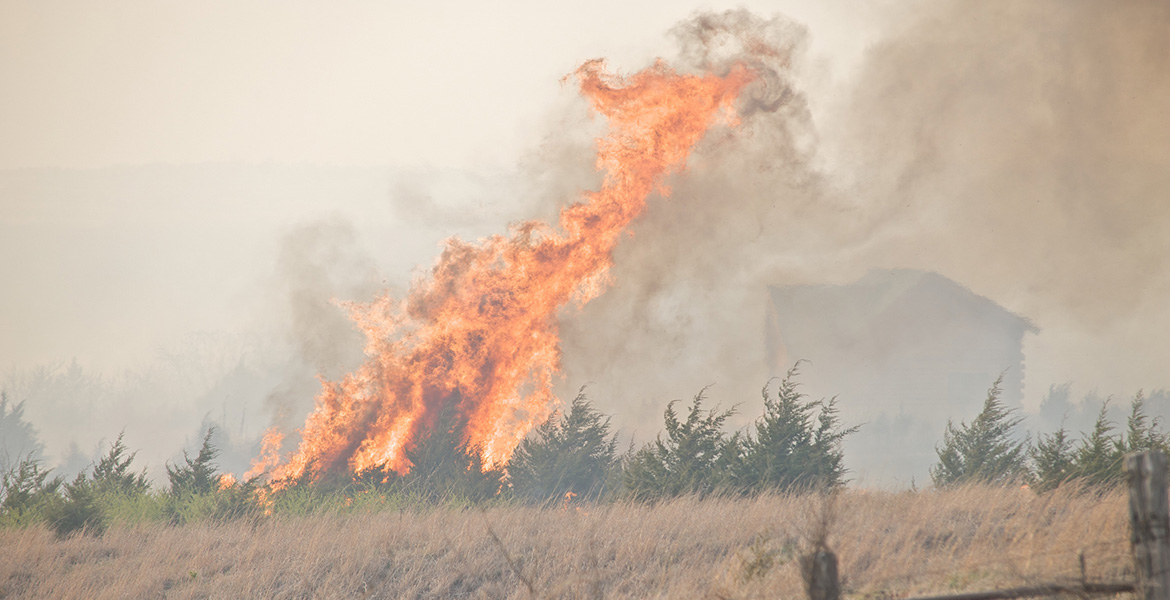
Tips for removing smoke odor following a wildfire
Tuesday, March 10, 2020
Beaver County residents have seen first-hand the devastating effects that wildfire can bring after recent wildfires in the state’s panhandle.
Some families lost their homes and outbuildings, while other structures in the path of the flames were spared.
However, even homes that were not damaged by flames may still have smoke damage, said Gina Peek, Oklahoma State University Cooperative Extension housing and consumer specialist.
“A fire in your neighborhood or on your acreage may cause your home to smell like smoke. The odor is caused by tiny microscopic particles that cling to walls, furniture, floors, clothing and other items inside your home,” Peek said. “Unfortunately, removing the smell isn’t as easy as spraying a can of air freshener or lighting a scented candle. These remedies only mask the smell for a short amount of time. You may need to have your furniture and mattresses professionally cleaned. Removing the smoke smell will take time, effort and money.”
There are some simple things that can be done to help remove odors, beginning with a deep cleaning. Smoke particles get into nooks and crannies and can be difficult to remove. Even though a home has been cleaned from top to bottom, if you did not get into those tiny areas, the smell may linger.
Homeowners also can use some common household items to help absorb the odor while they clean.
Baking soda is an inexpensive and natural odor-absorber. Peek suggested leaving a few bowls of baking soda around the house for several days for full effect.
“Activated charcoal also is an option to help absorb odors. Use it like you would baking soda and place it in bowls around the house for several days. Keep closet doors open, as well as other doors you may typically keep closed. Include kitchen and bathroom cabinets, too,” she said. “If the weather cooperates, open your windows and doors to let in the fresh air. If much of the area around your home burned, the smoke smell may remain for some time.”
Getting the smoke smell out of clothing can be a difficult and time consuming task. Try adding 1 cup of vinegar in the wash cycle, along with the usual detergent. Keep in mind one washing may not remove all the damage. If you still smell smoke when the clothes come out of the washing machine, immediately wash them again using the same process and continue until the smell is gone. Do not put clothes that smell like smoke in a drying machine because it can lock the odor in the material.
“A final option, homeowners may need to hire a professional to use an ozone generator to destroy the smoke molecules left behind after a fire,” she said. “This isn’t something homeowners should do themselves. There are significant health and property dangers associated with ozone. Check with your insurance company to see if this is covered under your policy. The use of an ozone generator will require the temporary evacuation of your home.”
Information on the Federal Emergency Management Agency (FEMA) website at https://www.fema.gov/ also has several tips for removing smoke odors, including:
- Pressure wash, scrub or disinfect all exterior surfaces including walls, walks, drives, decks, window and deck screens.
- Wash and disinfect all interior walls and hard surfaces with mild soap or other appropriate cleaning solutions or products, and rinse thoroughly. Do not forget inside cabinets, drawers and closets.
- Wash, dust or otherwise clean all household items, including knick-knacks.
- Clean and deodorize all carpets, window coverings, upholstered furniture and mattresses with steam or other appropriate equipment. Upholstery, fabric window treatments, etc., can be spray-treated with deodorizing products available at most supermarkets, but do not use odor-masking sprays.
- Have heating, ventilating and air-conditioning units and all ductwork professionally cleaned to remove soot, ash and smoke residue. Change filters when you first return to the premises and at least once a month for the first year.
- If aerial fire retardant or firefighting foam residue is present on the house and/or automobiles, use a mild detergent and brushes to scrub and dilute the dried residue and flush it from the surfaces; rinse with clean water. A follow-up with cleaning may be beneficial but will not replace scrubbing to remove the residue.
- Ash and soot on the ground and vegetation in the vicinity will continue to generate smoke odors and airborne particles when disturbed by air movement. Until the ash and soot are diluted and absorbed by the environment, indoor mechanical air filtration may help minimize the uncomfortable and potentially health-threatening impact of these pollutants.
“Dealing with fire and smoke damage can be devastating, but these tips should help those affected begin the cleanup process,” Peek said.
More wildfire information from OSU Cooperative Extension is available at https://extension.okstate.edu/wildfires.html. Additional information can be found at www.ready.gov and www.redcross.org.
MEDIA CONTACT: Trisha Gedon | Agricultural Communications Services | 405-744-3625 | trisha.gedon@okstate.edu
